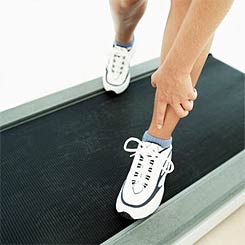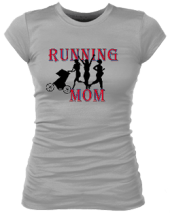10 Steps to Less Shin Pain
Shin pain is a very common complaint of runners, but it can be treated before it turns into shin splints. Try these 10 steps if you're feeling pain in your shins.
 |
1) Make sure your running shoes are right for you and not old and worn.
The first thing to go when my running shoes are worn out is my shins. So any time I am feeling shin pain, before I worry, I ask myself whether my running shoes need to be replaced.
If you just bought a new pair of running shoes and you're feeling shin pain, chances are they are not the right shoes for you. Here are some tips on how to choose the right running shoes for your gait.
If you've had your shoes for a while and all of the sudden you're feeling pain in your shins, chances are, your shoes are worn out and need to be replaced.
Do not continue running in your shoes. If you can't replace your running shoes right away, try cross training until you can replace them so as not to cause further pain and possible injury.
Running shoes not the answer? Move on to step 2.
2) Did you remember to warm up?
If you're starting out at a sprint without warming up properly, this can really hurt your shins.
It's easy to take off and forget to warm up, especially if you're racing. Instead take the first mile or 10 minutes slow and give your shins a chance to warm up properly before you start pounding them.
If you're racing and going for a PR, you might want to do an easy mile right before the race to give yourself a chance to warm up.
And just as important as warming up is cooling down for that last mile or so at the end of your run.
Warmped up properly and still feeling shin pain? Let's move on to step 3.
3) Where are you running?
Sometimes when I'm running on a concrete sidewalk, my shins really hurt. Then I'll move onto the asphalt road and instantaly the pain lessens.
Also, if you've just changed your terrain, your shins might hurt because they are still getting adjusted to this new terrain. On the other side, if you're training over and over agan on the same terrain, you might want to give your shins a break and try some new type of terrain.
So switch it up between concrete, asphalt, sand, trails, grass, treadmill and any other type of terrain and when you do, give shins a chance to adjust.
Not helping? OK, moving on to step 5.
5) Probably time to take a rest day.
If you're running every day, your body probably just needs a rest. Try taking a day off completely or do some cross training.
Now what do you do to sooth shoes shins?
6) Ice and Vitamin I
Some people get in a tub of ice water for 10-20 minutes. I've heard it does wonders in helping relieve shin pain. I prefer the old fashioned ice pack or if you don't have that, a package of frozen vegetables placed on the sore shin for about 10 minutes will do the trick.
Vitamin I (also known as Motrin or just plain ibuprofen) will also help relieve the pain. Just be careful with that stuff because it can be really bad for the kidneys, and while it might make the pain go away, it doesn't necessarily relieve the cause of the pain. But I will occasionally take this if the pain is bad enough to keep me from getting a good night sleep.
Now here are a couple things you can do to strengthen your shins and the muscles around them to lessen the shin pain.
7) Add weight training to your workout routine 2-3 times a week.
When I started having shin and knee pain during my training for my first marathon, my coach advised me to add strength training 2-3 times week and in just a week, I was feeling better.
The idea is, if you're upper legs are not strong enough to carry their own weight, the lower legs have to carry it all, and come on, they already take such a pounding! Give the little guys a break for once and make the big guys put in their fair share.
Here is an article on how to do weight training for runners.
8) Write the alphabet with your toes.
This is a trick I learned from my friend my friend Kari (she is also the one who wrote the article above on weight training).
One at a time, take each of your feet and draw the alphabet with your toes. This helps strengthen your shins.
9) Walk it out.
Sometimes just going for a walk, really helps relieve shin pain. Here are some times that you can throw in a walk.
Take a 1-2 minute walk breaks during your longer runs. This can help you train farther without exhausting or hurting yourself.
Walk for one minute for every mile you ran as a cool down at the end of your run.
Go for a walk on your day off, or later in the day after a run to literally walk out the pain.
I have no idea the scientic reasons behind it, I just know walking really helps relieve shin pain.
10) Wear compression socks.
This is what I did when I ran 30 miles for my 30th birthday without training properly.
Before I ran it, I called a friend who would be running it with me and is a really impressive runner and told her I didn't know if I could do it because my longest training run was only 13 miles and my shins were hurting. She replied, "just get some compression wraps for your shins."
Sure enough, I got these things that are like compression socks, only they go from the knee to the ankle, which is really nice, because I hate tight things around my feet and I had no shin pain during or after my run.
So if all else fails and you have a run to do that you didn't train properly, invest in a pair of compression socks. They are also great for wearing after your run to help with recovery.
Bonus Tip. Be Consistent.
If you're running day after day after day without taking a break, you probably need to take a rest.
HOWEVER, if you find yourself running spuradically and feeling pain in your shins every time, it could be that you're not training enough.
We all go through times where we're just not feeling it. I've had slow times as a running mom where one thing after another seems to come up and I find myself doing a week on a week off, a week on, two weeks off, two weeks on, three weeks off...and I find this is the time that I have the most problems with my shins.
Sometimes you just have to push through even when you're not feeling it, and after about a month or two of consistency (it really doesn't take that long when you really put your mind to it), you'll find that your shins and the rest of your body will start adjusting and give you a lot less problems.
More Tips
Here you can find some stretches for runners that are really good for helping to relieve shin pain.
Here are some more tips on helping to avoid running injuries.
Here are some tips to help you decide if you have a running injury, and how to deal with it.








